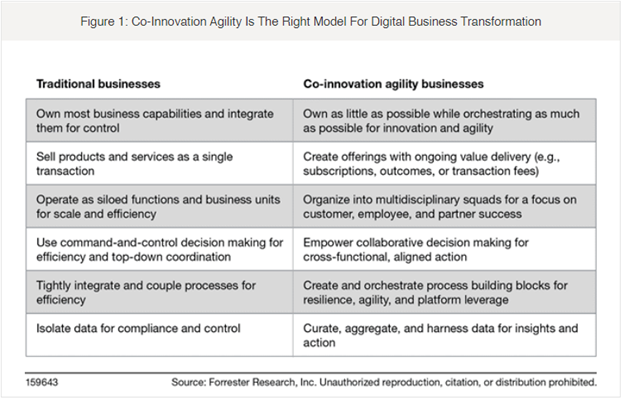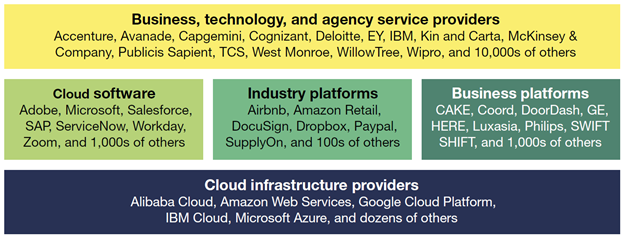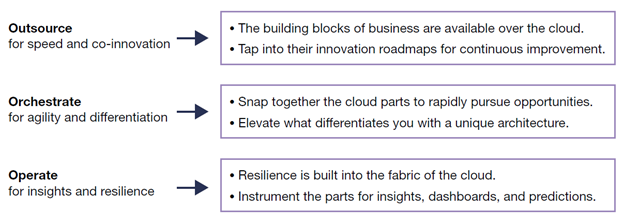- Blog
- Integration strength key for a successful, open S2P ecosystem
Integration strength key for a successful, open S2P ecosystem
Earlier this year we wrote about why a source-to-pay ecosystem is best practice. We talked about the early conversations you need to have with providers to understand the building blocks on which to build your ecosystem, the value of each ecosystem provider, and what it takes to evaluate the effectiveness of the ecosystem approach for your organisation. In this blog, we dive deeper into the specific benefits and research that supports this new approach to source-to-pay (S2P), the importance of seamless integrations, and industry analysts that are urging businesses to consider innovation through ecosystems.
Digital is the only responsible response to COVID-19
The transformation to digital processes is not a new concept, but it does take strategy and the right partnerships to get right. Prior to COVID-19, many companies liked the “idea” of digitisation, but many treated it as an optional add-on to their existing routine and only applied technology sporadically across their business units.
Today, prioritising digitisation is no longer optional. The uncertainty of the future and unique work environment requires a new technology approach – just to keep up. In Forrester’s report, “The Pandemic Recession Demands A Digital Response,” they state that “digital has been the only reasonable response to the COVID-19 crisis. And it’s the only reasonable response to the pandemic recession.” Focusing on how companies can scale their ability to adapt and grow in the post-pandemic era, Forrester encourages innovation through ecosystems to rebound quicker and increase speed to ROI.
Why a business ecosystem?
A business ecosystem is an open business philosophy driven by an open architecture, prioritising expertise via co-existence. Organisations that embrace a ‘best-of-breed’ ecosystem approach to develop their source-to-pay (S2P) operations, reap benefits like:
-
Accessing the most innovative technology on the market, now and in the future
-
Minimising your business risk with a proven integration methodology
-
Optimising costs and avoiding vendor lock-in issues while future-proofing S2P processes
-
Total data capture via a core spend management platform and analytics overlay
-
Faster implementation time and ROI on technology investments


A best-of-breed ecosystem approach is a reflection of the change in demand and increased complexity that businesses are now facing, and continues to gain traction as industry analysts have openly cited that no single provider can truly offer a full source-to-pay suite that is best in class across all modules and stages of the S2P process.
“Despite aggressive marketing, no vendor offers a full source to pay suite that is best in class across all modules. This means that deploying a full suite requires significant willingness to adopt ways of working within built-in best practices, and/or willingness to compromise on functionality. If too much compromise is made, you could end up with a solution that doesn’t fit your needs.” ~ Gartner
“While suites may appeal in theory, in practice clients generally don’t acquire a full suite at one time and certainly don’t implement all modules at ones. Vendors have a have a difficult time keeping all the products in the suite up to par with specialist products.” ~ Forrester
The power of a strong core
Just how the sun is the center of our galaxy, keeping our planets in orbit and life going as we know it, a strong core supports the safety and stability of an S2P ecosystem. To truly provide seamless integrations to other financial systems and cloud service providers, one must have a strong, data-driven procure-to-pay (P2P) core in place that centralises processes, gives complete spend visibility, and provides the plug-ins necessary to outsource and co-innovate.
In the graphic below, Forrester points out that it’s not just the high-tech industry that harnesses the cloud. Any provider with a digital service can offer it over the cloud, so companies can work with service providers to assemble and orchestrate the business building blocks they need, while gaining access to an ever-changing source of innovation and value.


Forrester’s take on innovation through ecosystems
According to Forrester, “Innovation through ecosystems happens when organisations actively collaborate with their cloud, software, and service providers, value-aligned through common purpose and financial incentives.”
In their recent report, they explain how agile firms have adjusted their approach to innovation through ecosystems to:
-
Outsource for speed and co-innovation.
-
Orchestrate for agility and differentiation.
-
Operate for insights and resilience.


They state that “Lean firms focus on their core and leverage the resources of others. To achieve this, your success is entirely dependent on how well you structure and manage your relationships with the universe of third-party resources and capabilities available over the cloud. We call this "innovation through ecosystems."
Integrate to innovate S2P
Integrations with existing solutions are critically important as today’s global corporations look for ways to continually innovate, improve processes, and work with the best partners. Traditional single suites are often made up of a myriad of systems due to various mergers and acquisitions, leaving room for clunky processes and decentralised data.
The ecosystem approach is designed to future-proof and provide more effective partnerships, covering all stages of S2P via open API technology, meaning it’s not dependent on a single provider or solution.
Using an ecosystem, companies can additionally expand their S2P processes and add value-adding services such as contract lifecycle management, request for quotation, supplier risk management, and more. All powered by the centralised core and enabled via seamless, integration capabilities.
Ease of Integration with Basware
Basware’s core procure-to-pay solutions consist of the Basware Network, electronic procurement (e-procurement), AP automation, supplier management and analytics. Each ensuring efficiencies and automations around the main buying and invoicing processes, allowing organisations to expand to broader S2P functionality with complementary solutions like those mentioned above and in the graphic below.


With an ecosystem approach, the P2P (or broader S2P) process can co-exist and complement existing solutions used by the client. This is particularly beneficial if an organisation or customer has already automated certain aspects of their process and wants to expand, while still maintaining 100% centralized visibility of data.
At Basware, our solutions seamlessly integrate with all ERP systems, proven by our experience with over 250 different ERP integrations. With built-in certified configurations, Basware bridges all the gaps between our solutions and multiple ERP systems and applications, assuring a consolidated view of data in one location.
Whether you’re expanding on existing solutions or looking to build your core P2P processes, Basware can help you get started. We understand the importance of ensuring rapid deployment, capturing 100% of your data, and improving processes through integration expertise and support.
Read the whole Forrester report
To adapt and grow, businesses must get lean, go all in on ecosystems, and embrace agile at scale. Forrester urges businesses to “Seize this moment. Use the motivation of the pandemic recession to become the business you want to be, to work your new digital muscles, and to strive to become a "future fit" firm that can rapidly sense and adapt to the world in which we live.”
Related
-
By Basware RepresentativeUnveiling CFO Strategies for Long-Term Value Creation – Webinar Insights
-
By Anu HämäläinenUnlocking the Power of AI in Finance: A Dive into Invoice Ingestion Revolution
-
By Christopher BlakeComplexity to Clarity: Forrester's Expert Take on AP Invoice Automation
-
By Christopher BlakeChoosing AP Excellence: Finding the Right Solutions Amid S2P Suite Challenges
-
By Basware RepresentativeUnlock the Power of Invoice Digitalization: Watch Our On-Demand Webinar Now!
-
By Basware RepresentativeAP Metrics that Matter – Webinar with Ardent Partners
-
By Sanna EklundHarnessing AI and ML to Transform AP
-
By Basware RepresentativeWhen Is The Right Time To Move To Touchless Invoice Processing

